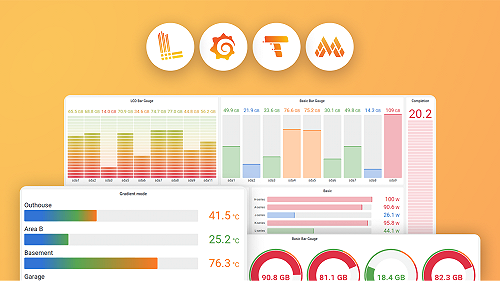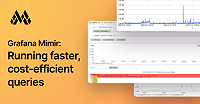Important: This documentation is about an older version. It's relevant only to the release noted, many of the features and functions have been updated or replaced. Please view the current version.
Collecting metrics and logs from Grafana Mimir
You can collect logs and metrics from a Mimir or GEM cluster. To set up dashboards and alerts, see Installing Grafana Mimir dashboards and alerts or Grafana Cloud: Self-hosted Grafana Mimir integration.
It is easier and best to monitor a cluster if it was installed via the Grafana Mimir Helm chart. For more information, see the documentation for the Grafana Mimir Helm chart.
It is also possible to use this integration if Mimir was deployed another way. For more information, see Collect metrics and logs without the Helm chart.
Collect metrics and logs without the Helm chart
You can still use the dashboards and rules in the monitoring-mixin, even if Mimir or GEM is not deployed via the Helm chart. If you are not using the Helm chart, start by using the Agent configuration from Collect metrics and logs via Grafana Agent. You might need to modify it. For more information, see dashboards and alerts requirements.
Service discovery
The Agent configuration relies on Kubernetes service discovery and Pod labels to constrain the collected metrics and
logs to ones that are strictly related to the Grafana Mimir deployment. If you are deploying Grafana Mimir on something other than Kubernetes,
then replace the kubernetes_sd_configs block with a block from
the Agent configuration that can discover the Mimir processes.
Collect metrics and logs via Grafana Agent
Set up a Grafana Agent that collects logs and metrics from Mimir or GEM. To set up Grafana Agent, see Set up Grafana Agent. After your Agent is deployed, use the example Agent configuration to configure the Agent to scrape Mimir or GEM.
Caveats
Managing your own Agent comes with some caveats:
- You will have to keep the Agent configuration up to date manually as you update the Mimir Helm chart. While we will try to keep this article up to date, we cannot guarantee that the example Agent configuration will always work.
- The static configuration makes some assumptions about the naming of the chart, such as that you have not overridden
the
fullnameOverridein the Helm chart. - The static configuration cannot be selective in the PersistentVolumes metrics it collects from Kubelet, so it will scrape metrics for all PersistentVolumes.
- The static configuration hardcodes the value of the
clusterlabel on all metrics and logs. This means that the configuration cannot account for multiple installations of the Helm chart.
If possible, upgrade the Mimir Helm chart to version 3.0 or higher and use the built-in Grafana Agent operator. Using the Agent operator allows the chart to automatically configure the Agent, eliminating the aforementioned caveats.
Example Agent configuration
In the following example Grafana Agent configuration file for collecting logs and metrics, replace url, password, and username in
the logs and metrics blocks with the details of your Prometheus and Loki clusters.
logs:
configs:
- clients:
- basic_auth:
password: xxx
username: xxx
url: https://example.com/loki/api/v1/push
name: integrations
positions:
filename: /tmp/positions.yaml
scrape_configs:
- job_name: integrations/grafana-mimir-logs
kubernetes_sd_configs:
- role: pod
pipeline_stages:
- cri: {}
relabel_configs:
- action: keep
regex: mimir-distributed-.*
source_labels:
- __meta_kubernetes_pod_label_helm_sh_chart
- source_labels:
- __meta_kubernetes_pod_node_name
target_label: __host__
- action: replace
replacement: $1
separator: /
source_labels:
- __meta_kubernetes_namespace
- __meta_kubernetes_pod_container_name
target_label: job
- action: replace
regex: ""
replacement: k8s-cluster
separator: ""
source_labels:
- cluster
target_label: cluster
- action: replace
source_labels:
- __meta_kubernetes_namespace
target_label: namespace
- action: replace
source_labels:
- __meta_kubernetes_pod_name
target_label: pod
- action: replace
source_labels:
- __meta_kubernetes_pod_container_name
target_label: name
- action: replace
source_labels:
- __meta_kubernetes_pod_container_name
target_label: container
- replacement: /var/log/pods/*$1/*.log
separator: /
source_labels:
- __meta_kubernetes_pod_uid
- __meta_kubernetes_pod_container_name
target_label: __path__
target_config:
sync_period: 10s
metrics:
configs:
- name: integrations
remote_write:
- basic_auth:
password: xxx
username: xxx
url: https://example.com/api/prom/push
scrape_configs:
- job_name: integrations/grafana-mimir/kube-state-metrics
kubernetes_sd_configs:
- role: pod
metric_relabel_configs:
- action: keep
regex: (.*-mimir-)?alertmanager.*|(.*-mimir-)?compactor.*|(.*-mimir-)?distributor.*|(.*-mimir-)?(gateway|cortex-gw|cortex-gw).*|(.*-mimir-)?ingester.*|(.*-mimir-)?querier.*|(.*-mimir-)?query-frontend.*|(.*-mimir-)?query-scheduler.*|(.*-mimir-)?ruler.*|(.*-mimir-)?store-gateway.*
separator: ""
source_labels:
- deployment
- statefulset
- pod
relabel_configs:
- action: keep
regex: kube-state-metrics
source_labels:
- __meta_kubernetes_pod_label_app_kubernetes_io_name
- action: replace
regex: ""
replacement: k8s-cluster
separator: ""
source_labels:
- cluster
target_label: cluster
- bearer_token_file: /var/run/secrets/kubernetes.io/serviceaccount/token
job_name: integrations/grafana-mimir/kubelet
kubernetes_sd_configs:
- role: node
metric_relabel_configs:
- action: keep
regex: kubelet_volume_stats.*
source_labels:
- __name__
relabel_configs:
- replacement: kubernetes.default.svc.cluster.local:443
target_label: __address__
- regex: (.+)
replacement: /api/v1/nodes/${1}/proxy/metrics
source_labels:
- __meta_kubernetes_node_name
target_label: __metrics_path__
- action: replace
regex: ""
replacement: k8s-cluster
separator: ""
source_labels:
- cluster
target_label: cluster
scheme: https
tls_config:
ca_file: /var/run/secrets/kubernetes.io/serviceaccount/ca.crt
insecure_skip_verify: false
server_name: kubernetes
- bearer_token_file: /var/run/secrets/kubernetes.io/serviceaccount/token
job_name: integrations/grafana-mimir/cadvisor
kubernetes_sd_configs:
- role: node
metric_relabel_configs:
- action: keep
regex: (.*-mimir-)?alertmanager.*|(.*-mimir-)?compactor.*|(.*-mimir-)?distributor.*|(.*-mimir-)?(gateway|cortex-gw|cortex-gw).*|(.*-mimir-)?ingester.*|(.*-mimir-)?querier.*|(.*-mimir-)?query-frontend.*|(.*-mimir-)?query-scheduler.*|(.*-mimir-)?ruler.*|(.*-mimir-)?store-gateway.*
source_labels:
- pod
relabel_configs:
- replacement: kubernetes.default.svc.cluster.local:443
target_label: __address__
- regex: (.+)
replacement: /api/v1/nodes/${1}/proxy/metrics/cadvisor
source_labels:
- __meta_kubernetes_node_name
target_label: __metrics_path__
- action: replace
regex: ""
replacement: k8s-cluster
separator: ""
source_labels:
- cluster
target_label: cluster
scheme: https
tls_config:
ca_file: /var/run/secrets/kubernetes.io/serviceaccount/ca.crt
insecure_skip_verify: false
server_name: kubernetes
- job_name: integrations/grafana-mimir/metrics
kubernetes_sd_configs:
- role: pod
relabel_configs:
- action: keep
regex: .*metrics
source_labels:
- __meta_kubernetes_pod_container_port_name
- action: keep
regex: mimir-distributed-.*
source_labels:
- __meta_kubernetes_pod_label_helm_sh_chart
- action: replace
regex: ""
replacement: k8s-cluster
separator: ""
source_labels:
- cluster
target_label: cluster
- action: replace
source_labels:
- __meta_kubernetes_namespace
target_label: namespace
- action: replace
source_labels:
- __meta_kubernetes_pod_name
target_label: pod
- action: replace
source_labels:
- __meta_kubernetes_pod_container_name
target_label: container
- action: replace
separator: ""
source_labels:
- __meta_kubernetes_pod_label_name
- __meta_kubernetes_pod_label_app_kubernetes_io_component
target_label: __tmp_component_name
- action: replace
separator: /
source_labels:
- __meta_kubernetes_namespace
- __tmp_component_name
target_label: job
- action: replace
source_labels:
- __meta_kubernetes_pod_node_name
target_label: instance
global:
scrape_interval: 15s
wal_directory: /tmp/grafana-agent-wal

